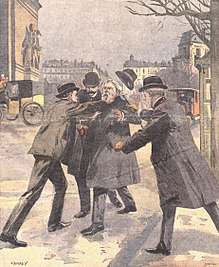Incursio




Incursio,[1] vel Latinitate recentiori aggressio, est interactio socialis, aperta aut occulta, saepe noxia, hominis vel gregis in animo habentis detrimentum vel aliud incommodum de alio homine vel grege sumere, quae agitatio aut responsum dans aut sine irritamento incitata fieri potest. Incursio inter homines variis stimulis efficitur, inter quos sunt frustratio finium obstructorum causá et sensus neglegentiae vel reiectionis.[2] Incursio humana in actiones rectam et indirectam digeritur.[3][4]
Res geneticae
[recensere | fontem recensere]Studium geminorum et alia examina clinica et genetica de facto gena incursionem proferentia exstare patefecerunt. Incursio phaenotypus sane non ab allelo singulari pendit, at quaeque allela ad incursionem collationes suas conferre possunt, ut:
- Variantes enzymi monoaminorum oxidasis A (MAOA)[5]
- Variantes enzymi tryptophani hydroxylasis 2 (TPH2, synthesis serotonini)[6]
- Variantes enzymi catechol-O-methyltransferasis (COMT)[7]
Notae
[recensere | fontem recensere]- ↑ John C. Traupman, Latin and English Dictionary, ed. tertia (Novi Eboraci: Bantam Books, 2007), 461, s.v. "aggression." Confer D. P. Simpson, Cassell's Latin Dictionary (Novi Eboraci: Wiley Publishing, 1968), 655, s.v. "aggression": "impetus (ūs), incursio, incursus (ūs), iniuria; often use ultro with verb."
- ↑ DeBono et Muraven 2014.
- ↑ De Almeida, Rosa Maria Martins; Cabral, João Carlos Centurion; Narvaes, Rodrigo (2015). "Behavioural, hormonal and neurobiological mechanisms of aggressive behaviour in human and nonhuman primates". Physiology & Behavior 143: 121–35.
- ↑ Miczek, Klaus A.; Almeida, Rosa M. M. de; Kravitz, Edward A.; Rissman, Emilie F.; Boer, Sietse F. de; Raine, Adrian (31 Octobris 2007). "Neurobiology of Escalated Aggression and Violence". Journal of Neuroscience 27 (44): 11803–11806.
- ↑ Schlüter T., Winz O., et al. (2016). "MAOA-VNTR polymorphism modulates context-dependent dopamine release and aggressive behavior in males". NeuroImage 125 (378-85)
- ↑ Kulikova E. A., Kulikov A. V. (Aug 2019). "Tryptophan hydroxylase 2 as a therapeutic target for psychiatric disorders: focus on animal models". Expert opinion on therapeutic targets 23 (8): 655-67
- ↑ Strous R. D., Nolan K. A., et al. (Iul 2003). "Aggressive behavior in schizophrenia is associated with the low enzyme activity COMT polymorphism: a replication study". American journal of medical genetics. Part B. 120B (1): 29-34
Bibliographa
[recensere | fontem recensere]Litterae interdisciplinariae
[recensere | fontem recensere]- Dennen, Johan van der. 1980. "Problems in the Concepts and Definitions of Aggression, Violence and Some Related Terms." PDF.
- Lorenz, Konrad. (1963) 1998. Das sogenannte Böse: Zur Naturgeschichte der Aggression. Monaci. ISBN 3-423-33017-1.
- Wahl, Klaus. 2012. Aggression und Gewalt: Ein biologischer, psychologischer und sozialwissenschaftlicher Überblick. Heidelbergae: Spektrum Akademischer Verlag. ISBN 978-3-8274-3120-2.
- Wahl, Klaus, et Melanie Rh. Wahl. 2013. "Biotische, psychische und soziale Bedingungen für Aggression und Gewalt." In Handbuch Politische Gewalt. Formen – Ursachen – Legitimation – Begrenzung, ed. Birgit Enzmann, 15–42. Wiesbaden: Springer VS. ISBN 978-3-531-18081-6.
Biologia, evolutio, neurobiologia
[recensere | fontem recensere]- Bauer, Joachim. 2011. Schmerzgrenze: Vom Ursprung alltäglicher und globaler Gewalt. Monaci: Blessing. ISBN 978-3-89667-437-1.
- Hartup, Willard W., et Jan de Wit, eds. 1978. Origins of aggression. Hagae: Mouton. ISBN 9027976732.
- Heinrichs, M., et G. Domes. 2008. "Neuropeptides and social behaviour: Effects of oxytocin and vasopressin in humans." Advances in Vasopressin and Oxytocin: from Genes to Behaviour to Disease." Progress in Brain Research 170: 337–50. doi:10.1016/S0079-6123(08)00428-7. ISBN 978-0-444-53201-5. PMID 18655894.
- Morris, Desmond. 1968. Der nackte Affe. Droemer Knaur. ISBN 3-426-03224-4.
- Storr, Anthony. 1968. Human aggression. Londinii: Allen Lane, The Penguin Press.
- Walton, Kenneth G., et Debra K. Levitsky. 2003. "Effects of the Transcendental Meditation Program on Neuroendocrine Abnormalities Associated with Aggression and Crime." Journal of Offender Rehabilitation 36 (1–4): 67–87. doi:10.1300/J076v36n01_04.
Psychologia
[recensere | fontem recensere]- Bandura, Albert. 1979. Aggression: Eine sozial-lerntheoretische Analyse. Stutgartiae: Klett-Cotta. ISBN 3-12-920521-7.
- Baron, R., et D. Richardson. (1994) 1997. Human Aggression. Novi Eboraci: Plenum Press.
- Berkowitz, Leonard. 1969. Roots of aggression; a re-examination of the frustration-aggression hypothesis. Novi Eboraci: Atherton Press.
- DeBono, Amber, et Mark Muraven. 2014. "Rejection perceptions: feeling disrespected leads to greater aggression than feeling disliked." Journal of Experimental Social Psychology 55 (1 Novembris): 43–52. doi:10.1016/j.jesp.2014.05.014|issn=0022-1031.
- Dutschmann, Andreas. 2000. Das Aggressions-Bewältigungs-Programm (ABPro). Tubingae: Dgvt-Verlag. ISBN 3-87159-303-6.
- Euler, H. A. 2004. "Die Beitragsfähigkeit der evolutionären Psychologie zur Erklärung von Gewalt." In Gewalt Entwicklungen, Strukturen, Analyseprobleme, ed. W. Heitmeyer et H.-G. Soeffner. Frankfurt am Main, 411–435.
- Fields, R. Douglas. 2019. "The Roots of Human Aggression: Experiments in humans and animals have started to identify how violent behaviors begin in the brain." Scientific American 320, no. 5 (Maius): 64–71.
- Gacono, Carl B., et J. Reid Meloy. 1994. The Rorschach assessment of aggressive and psychopathic personalities Hillsdale, Novae Caesareae: Erlbaum. ISBN 0805809805.
- Fürntratt, Ernst. (1974) 2000. "Angst und instrumentelle Aggression." In Lernfall Aggression, ed. undevicensima, ed. H. P. Nolting. Reinbek.
- Hartdegen, Karsten. 1996. Aggression und Gewalt in der Pflege. Monaci: Urban & Fischer Verlag.
- Heinelt, Gottfried. 1982. Einführung in die Psychologie des Jugendalters: Ein Grundkurs mit vielen Beispielen für die Praxis. Freiburg im Breisgau.
- Heinemann, E. 1996. Aggression: Verstehen und bewältigen. Berolini et Heidelbergae.
- Kühne, Norbert. 2008. "Umgang mit Aggression." In Praxisbuch Sozialpädagogik, 6: 111–137. Coloniae: Bildungsverlag EINS. ISBN 978-3-427-75414-5.
- Kunz, Hans. 2004. Aggressivität, Zärtlichkeit und Sexualität. Werke, 4. Frauenfeld: Huber.
- Lamnek, Siegfried, Jens Luedtke, et Ralf Ottermann. 2006. Tatort Familie: Häusliche Gewalt im gesellschaftlichen Kontext. Ed. secunda. Wiesbaden: VS Verlag. ISBN 3-531-15140-1.
- Marcus, Robert F. 2007. Aggression and violence in adolescence. Cantabrigiae et Novi Eboraci: Cambridge University Press. ISBN 9780521868815, ISBN 9780521688918.
- Milgram, Stanley. "A behavioral study of obedience." Journal of Abnormal and Social Psychology 67: 371–78.
- Mummendey, Amélie. 1993. Bedingungen aggressiven Verhaltens. Bernae: Huber. ISBN 3-456-30464-1.
- Otten, S., et A. Mummendey. 2002. "Sozialpsychologische Theorien aggressiven Verhaltens." In Theorien der Sozialpsychologie, vol. 2, ed. D. Frey et Martin Irle. Bernae, Gotingae, Toronti, Seattli: Verlag Hans Huber.
- Nolting, Hans-Peter. (1978) 2005. Lernfall Aggression: Wie sie entsteht – wie sie zu vermindern ist. Eine Einführung. Reinbek: Rowohlt.
- Plack, Arno, ed. 1973. Der Mythos vom Aggressionstrieb. Monaci: List. ISBN 3-471-66531-5.
- Selg, Herbert, Ulrich Mees, et Detlef Berg. 1997. Psychologie der Aggressivität. Ed. secunda. Gotingae: Hogrefe-Verlag für Psychologie. ISBN 3-8017-1019-X.
- Staemmler, Frank-M. et Rolf Merten, eds. 2006. Aggression, Selbstbehauptung, Zivilcourage: Zwischen Destruktivität und engagierter Menschlichkeit. Bergisch Gladbach: EHP.
Psychoanalysis et psychiatria
[recensere | fontem recensere]- Fromm, Erich. 1977. Anatomie der menschlichen Destruktivität. Reinbek: Rowohlt.
- Goldman, George D., et Donald S. Milman, eds. 1978. Psychoanalytic perspectives on aggression. Dubuque Iovae: Kendall/Hunt Publishing Company. ISBN 0840318006.
- Hacker, Fridericus. 1971. Aggression. Die Brutalisierung der modernen Welt. Vindobonae: Molden Verlag.
- Merz, F. (1965) 2000. "Aggression und Aggressionstrieb." In Lernfall Aggression. Editio undevicensima, Reinbek bei Hamburg.
Iurisprudentia
[recensere | fontem recensere]- Hacker, Friedrich. 1964. Versagt der Mensch oder die Gesellschaft? Probleme der modernen Kriminalpsychologie. Vindobonae: Europa Verlag.
- Hummrich, Martin. 2001. Der völkerrechtliche Straftatbestand der Aggression. Baden-Baden.
Nexus interni
- Aggressionismus
- Antagonista
- Anxietas
- Bellum
- Bellum omnium contra omnes
- Bellum psychologicum
- Crudelitas
- Furor
- Renatus Girard
- Homo homini lupus
- Incursio magna
- Instinctus naturae
- Ira
- Conradus Lorenz
- Misanthropia
- Odium
- Polemica
- Scelus odio commissum
- Ultio
- Victimae
- Violentia
Nexus externi
[recensere | fontem recensere]| Vide incursionem in Victionario. |
| Vicicitatio habet citationes quae ad incursionem spectant. |
| Vicimedia Communia plura habent quae ad incursionem spectant. |
- "When Family Life Hurts: Family experience of aggression in children." Parentline plus, 31 Octobris 2010.
- Aggression and Violent Behavior, a Review Journal.
- International Society for Research on Aggression.
- "Aggression and brain asymmetry."
- "Aggression und präventive Maßnahmen."
- "Fachartikel: Aggression bei Kindern."
- "Stichwort: Aggression." Lexikon der Gestalttherapie.
- "Spiele & Übungen zum Umgang mit Aggression."
- "Humanethologische Aspekte der Aggression: Die Sichtweise der so genannten klassischen vergleichenden Verhaltensforschung." PDF.
- AGGRESSION: Gefährliches Gerede. Der Spiegel, 26 Iunii 1972.
Text is available under the CC BY-SA 4.0 license; additional terms may apply.
Images, videos and audio are available under their respective licenses.
